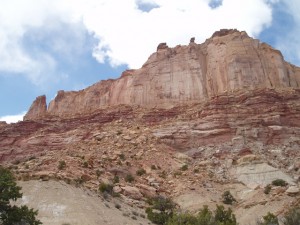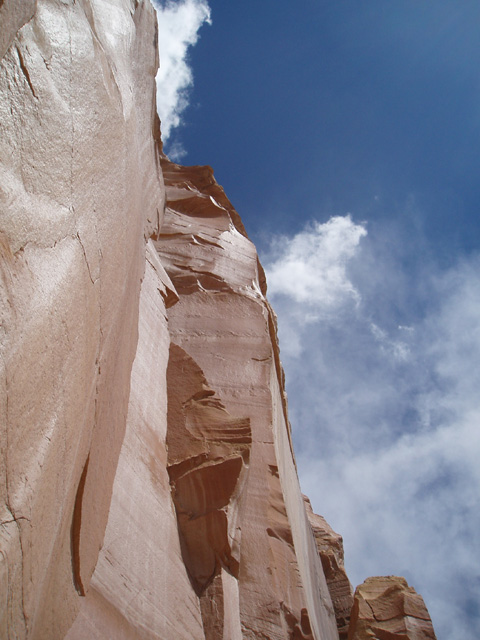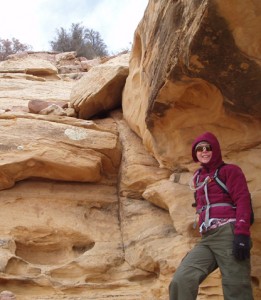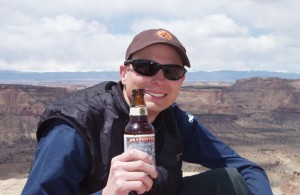 The San Rafael Swell, gouged by canyons and checkered with sandstone towers and mesas doesn’t present the same majestic summitBrew opportunities as the nearby LaSal or Henry mountain ranges, but with most Utah peaks still saturated in white, a 7,000 foot tower less than 3 hours driving from Salt Lake earned the distinction of being my first summitBrew post. At exactly 7,010 feet, Pinnacle #1 slots in near the bottom on my collection of peaks, however, the journey to the top of this crumbling, Parthenon like ruin south of the San Rafael River is an instance where the often ambiguous and quantifiable definitions of a “mountain top” submit to a more qualitative and subjective definition.
The San Rafael Swell, gouged by canyons and checkered with sandstone towers and mesas doesn’t present the same majestic summitBrew opportunities as the nearby LaSal or Henry mountain ranges, but with most Utah peaks still saturated in white, a 7,000 foot tower less than 3 hours driving from Salt Lake earned the distinction of being my first summitBrew post. At exactly 7,010 feet, Pinnacle #1 slots in near the bottom on my collection of peaks, however, the journey to the top of this crumbling, Parthenon like ruin south of the San Rafael River is an instance where the often ambiguous and quantifiable definitions of a “mountain top” submit to a more qualitative and subjective definition.
As my girlfriend and I drove south from the San Rafael River campground, the sandstone corridors that surround the river widened and we were driving through a vast, high desert where the friable edges of countless mesas and buttes ran for miles. To the right, a prominent wall of smooth rock sprouted up from a long multi-colored mesa that was littered with boulders and gravel along it’s edge. The wall atop this mesa was Pinnacle #1, and like most Utah towers, it looked impossible to climb without aid. However, the route to the crumbling parapets on top of the Pinnacle runs around the wall and to the opposite side, where a steep, but climbable course is found. The route is well detailed in Steve Allen’s Canyoneering: The San Rafael Swell.
We began our hike by walking about a mile from the road towards the largest debris pile that spills down the side of the mesa. After an easy scramble up the debris pile, we were at the foot of the 600′ face of the Pinnacle. The slick, solid, massive wall was pretty impressive to stare up at, especially with the blue sky above and miniaturized desert below. It stood there stoically, like the remnants of a besieged castle, but after traversing north around the base of the wall, then back south behind it, we saw the perfect construction of the east face was not matched by the west.
The slick, solid, massive wall was pretty impressive to stare up at, especially with the blue sky above and miniaturized desert below. It stood there stoically, like the remnants of a besieged castle, but after traversing north around the base of the wall, then back south behind it, we saw the perfect construction of the east face was not matched by the west.
While steep, the backside of this monolith had large layers of rounded sandstone, burrowed with numerous erosion holes and sprinkled with large boulders. The round amphitheater continued all the way up to a point just 10 to 15 feet below the top of the wall. From there, the summit was reachable over some boulders below the flat highpoint of the wall.
Allen’s book describes two class 4 sections, which, admittedly, I didn’t know what to make of. I have a general idea of what makes a climb class 4, but I don’t normally climb summits with class 4 sections. Maybe I have climbed peaks with class 4 sections in the past but since this was the first documented occurrence of a class 4 on one of my hikes, I was a little curious. The first section (right below the start of the amphitheater climb) was a pretty straight forward 10′ section that involved scaling some cracked boulders and grabbing a juniper branch; nothing major. The second section, not far beyond it, created a bit of a delay. Exposure wasn’t a problem on either of these climbs, but a missed foothold or poor hand hold could have left us injured and quite a ways from help. The two of us evaluated the various Swiss cheese holes and cracks for a while before my girlfriend found the magic combination and made it up this 15′ section.
The gauntlet had been thrown and I would have to stretch my limited climbing skills or risk explaining why my summitBrew was drank by proxy by my girlfriend. She doesn’t even like beer, so I knew I had to get up this thing. I can’t really remember what I did, but once I got over my fear of having my head further back than my feet, it went pretty well. I know my climbing friends would have laughed, but I’m a scrambler, not a climber and moves like that always feel a little weird to me.
From there, it was pretty simple to get to the top. On the perch above the wall, the severe drop to the plain below was stunning. Unlike most mountain views which are a maze of recessed canyons and peaks that bar your view, what we saw from the top was miles of the Swell surrounded by the high, snowcapped ridges of the Fish Lake and Wasatch Plateaus. To the east, we could make out the LaSals. Barely visible over to the southwest was 1000 Lake Mountain and the Henry Mountains. I was only 1,100′ above the surrounding terrain, but it felt so much more than that. I pulled out the inaugural summit brew, a North Coast Pranqster, a Belgian Style Golden Ale, and enjoyed a cold beer.  The spice note of Pranqster is what I expected from a Belgian beer: wheat and bit of cloves with a fruity tone. But the aftertaste didn’t linger heavily. Instead, the spice subtly lingered, which made the down-climb pleasant. [However, most of what I tasted on the down-climb was the HemanJaeger Beef Sticks from the Piggly Wiggly back in my hometown of Green Bay, so in the future, I’ll try to bring more subtle trail snacks for these reviews.] The taste had a slight banana finish but was very clean and crisp, perfect for the desert. Very little head to no head and more carbonation than I usually see in Belgian beers. It seemed like a German take on a Belgian beer, which is probably why I liked it. The beer didn’t leave any lace on the glass [which is something I had to determine at home since I was not transporting a mug up there] and even though it’s alcohol by volume is 7.6%, there was very little of the overbearing weight that you usually get in Belgian beers. However, the alcohol content was something I didn’t really take into account until the prospect of down-climbing those two class 4 sections with a beer in me seemed a bit daunting. I poured a little of the brew out as an offering to the gods for the beautiful, albeit, windy and cold day and my girlfriend also did her part to prevent booze influenced injury by having a sip herself. Originally, I thought this was my first time tasting the Fort Bragg brewery’s Pranqster, but my girlfriend, who has made an annual tradition of giving me 12 beers of Christmas, claims this is one that may have been on a past list. Either way, I felt like I was drinking it for the first time and enjoyed its perfect balance between a round, fruity flavor and a sharp, yeasty bite while absorbing the view around me. In the past, I’ve started summit approaches at a higher altitude than where I sat that afternoon, but Pinnacle #1’s relative stature and the stunning vantage achieved at its top were every bit deserving of a summit brew.
The spice note of Pranqster is what I expected from a Belgian beer: wheat and bit of cloves with a fruity tone. But the aftertaste didn’t linger heavily. Instead, the spice subtly lingered, which made the down-climb pleasant. [However, most of what I tasted on the down-climb was the HemanJaeger Beef Sticks from the Piggly Wiggly back in my hometown of Green Bay, so in the future, I’ll try to bring more subtle trail snacks for these reviews.] The taste had a slight banana finish but was very clean and crisp, perfect for the desert. Very little head to no head and more carbonation than I usually see in Belgian beers. It seemed like a German take on a Belgian beer, which is probably why I liked it. The beer didn’t leave any lace on the glass [which is something I had to determine at home since I was not transporting a mug up there] and even though it’s alcohol by volume is 7.6%, there was very little of the overbearing weight that you usually get in Belgian beers. However, the alcohol content was something I didn’t really take into account until the prospect of down-climbing those two class 4 sections with a beer in me seemed a bit daunting. I poured a little of the brew out as an offering to the gods for the beautiful, albeit, windy and cold day and my girlfriend also did her part to prevent booze influenced injury by having a sip herself. Originally, I thought this was my first time tasting the Fort Bragg brewery’s Pranqster, but my girlfriend, who has made an annual tradition of giving me 12 beers of Christmas, claims this is one that may have been on a past list. Either way, I felt like I was drinking it for the first time and enjoyed its perfect balance between a round, fruity flavor and a sharp, yeasty bite while absorbing the view around me. In the past, I’ve started summit approaches at a higher altitude than where I sat that afternoon, but Pinnacle #1’s relative stature and the stunning vantage achieved at its top were every bit deserving of a summit brew.
